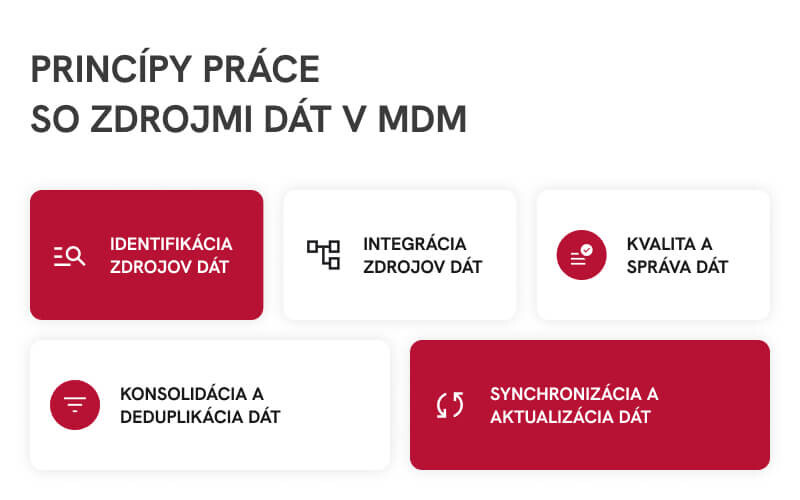Optimizing Data Quality: Mastering the Essentials of Data Management (MDM)
2024-01-02
Management of key data, known as Master Data Management (MDM), is a tool aimed at optimizing and managing data quality. MDM also participates in data migration and decision-making processes in the enterprise by ensuring consistent and reliable data across the entire enterprise infrastructure. Properly configured, MDM results in maximizing their validity and information support for enterprise decision-making processes.

Master Data Management (MDM) represents a comprehensive set of practices designed to ensure
- integrity,
- quality,
- stewardship,
- and uniformity of reference data (called master data)
across the organization.
Master data can include data about customers, products, employees, suppliers, and other entities important to the proper operation of the business.
Data quality and consistency are key to good decision making across the enterprise. Every decision-making process, whether it is
- strategic planning,
- predictive analysis,
- or daily operations,
is dependent on the accuracy, consistency and availability of data. Without consistent and high-quality data, there is a risk of
- of erroneous analyses,
- loss of efficiency,
- unnecessary costs
and, ultimately, negatively translate into the management of the business.
The implementation of MDM can help prevent the above problems by providing
- a single view of the data,
- eliminates duplicates,
- improves data accuracy and integrity,
- and enables efficient lifecycle management.
A Master Data Management (MDM) system is a set of components and modules that work together to provide a unified and high-quality set of master data across the entire organization. The key components and modules of an MDM system typically include:
-
- Data Model: defines the structure and relationships between tables and data types. A flexible data model is the foundation for an effective MDM system.
-
- Data Governance: A module that is responsible for defining and managing the rules and policies for working with data. It includes tools for metadata management, change tracking, auditing, and attribute value variance reporting.
-
- Data Quality Module: Its primary focus is data cleansing, enrichment, deduplication, and validation. It includes tools for identifying and correcting errors, as well as for identifying and enriching records by integrating to external communicators (registries).
-
- Data Integration: component providing seamless integration of data from different sources into the MDM system. The integration can take place through ETL or ELT approaches, where data is suitably transformed and populated into data structures.
-
- Data Server: the central storage component that maintains the master data. It provides fast data access and manipulation and can be optimized for specific requirements such as high availability or distributed processing.
-
- APIs and Services: enable the MDM system to interact with other applications and systems in the organization. APIs and services enable access, manipulation, and real-time synchronization of master data.

MDM architecture is a complex system that consists of several layers. Each layer is responsible for a specific function within the overall system.
The layers can be divided into:
-
- Data Ingestion Layer (DIL): It includes all the mechanisms needed to collect and integrate data from different sources. Tools with data access through ETL or ELT processes are used to extract data from different sources, transform it into the required form and load it into the MDM system. The layer also includes interfaces for connecting various data sources, including databases, applications, web services, and others.
-
- Data Processing Layer: All major operations on data are performed here, including data cleansing, validation, enrichment, deduplication, and identification. This layer is also responsible for metadata management and the implementation of rules and policies defined within the data management system.
-
- Data Storage Layer: Responsible for the storage and management of data. It can include different types of storage, including relational databases, NoSQL databases, Hadoop systems, and others. This layer also ensures high availability and reliability of data.
-
- Data Presentation Layer: Provides interfaces and services that enable access and interaction with data. It includes APIs, web services or graphical interfaces that allow users and applications to interact with the data.
-
- Management Layer: Includes the tools and services needed to monitor, manage, and optimize the entire MDM system. It includes tools for configuration management, performance monitoring, logging, security, and other aspects of IT infrastructure management.
-
- Security Layer: Responsible for protecting data and the system as a whole. It implements various security mechanisms, including authentication, authorization, data encryption, auditing, and other security protocols and procedures.
-
- Data Lifecycle Management Layer: Manages the lifecycle of data from creation to deletion. It includes functions such as archiving, backup, recovery, and disposal of data.
-
- Analytics and Performance Management Layer: Provides tools and services to measure and analyze data quality, system performance, and other relevant metrics. This analysis enables organizations to continuously improve their MDM initiatives and achieve their data quality goals.
For an MDM system to be effective and add value to the enterprise requires clearly defined processes and rules. The technology component is an important part of implementing MDM in the enterprise, but successfully implementing it in an organization requires, in particular
-
- management of the deployment process,
- high quality data standards
- close cooperation between IT and business departments.
All layers of the MDM architecture are involved in achieving this goal.
PRINCIPLES OF WORKING WITH DATA SOURCES IN MDM
The principles of working with data sources within MDM are an integral part of effective data management and can be divided into several key areas:

1) identification of data sources
The first step in working with data sources is to identify them correctly. It is important to map all available data sources in the enterprise that could contribute to the creation of a flexible data model. Identification includes internal systems, external databases, cloud storage and more. In the process of implementing an MDM solution, it is essential to have a clear picture of where resources come from and through which channels data flows to and from them.
The process begins with a detailed analysis of the existing information systems at the enterprise. It identifies systems such as ERP or CRM that record and store data, while also taking into account specific software tools or internal databases used by individual departments or teams. In this step, it is crucial to have a technical understanding of the architecture of Information Systems, their interactions with each other and the possibilities of data extraction.
Next follows the Identify relevant external sources. This includes databases provided by third parties, partner databases or industry standard databases. Nowadays, various cloud repositories are also increasingly used, which contain data relevant to MDM management.
When identifying data sources, one should not forget about the analysis of data flows. It is necessary to understand how data flows between different systems and processes in the enterprise, to identify the key points where data is generated, transformed or stored. Data flow analysis helps to identify possible weaknesses in data processes, while allowing more efficient planning of MDM implementation.
It is also important that identified data sources are classified and prioritized according to their relevance. For example, the key to assessing relevance may be the type of data, the frequency of updates, or the importance of the data to the organization. Thus, prioritization is an argument when deciding which data sources will be integrated into the MDM system first.
2) integration of data sources
After identification of data sources, their mutual integration follows. The MDM system should be able to communicate and interact with different data sources to ensure their consistency and accuracy. Integration may involve the use of APIs, ETL tools, or system-specific connectors (adapters).
Integration of data sources is a key point in the implementation of MDM solutions, and in terms of complexity and technical complexity, it is one of the most demanding parts of the process.
The first step of integration is the selection of optimal methods for data transfer between the MDM system and its data sources. In some cases, it is possible to use the existing API (Application Programming Interface), as it allows secure and efficient communication between systems, while supporting various data formats and methods of their transmission or update.
If the API is not available or not flexible enough for MDM needs, it is possible to use ETL (Extract, Transform, Load). ETL processes are especially useful when we need to extract large amounts of data from individual sources, transform them into the desired format, and then load them into the MDM system.
In some cases, it is necessary to create specific connectors for individual systems. These connectors are designed to enable reliable and efficient communication between the MDM system and the data source. The connectors can be custom designed for specific systems, ensuring a high degree of customization and ensuring all data is processed correctly and efficiently.
When integrating data sources, it is also important to take into account security aspects. Data transfer between systems is a potential security vulnerability. Therefore, it is necessary to ensure that all data is transmitted and stored by means of data encryption, the use of secure protocols or the implementation of access controls.
3) data consolidation and deduplication
The next step is to consolidate data from different sources and deduplicate them. The MDM system should be able to identify duplicate records and consolidate them into one consistent record while maintaining data integrity and accuracy.
Data consolidation and deduplication are key aspects of working with an MDM system and require a great deal of expertise and technical understanding. During the consolidation phase, data from different sources are collected and combined into a single, consistent and unified form. This process is not only about simply merging data, but also ensuring that the resulting data is clean, consistent and accurate.
Deduplication is the step that follows consolidation. The main goal of deduplication is to identify and remove duplicate records that may occur during the consolidation phase. This process is significant not only in terms of saving storage space, but above all in terms of data quality. Duplicate records can lead to incorrect analysis results and unwanted problems in data - driven processes to automate data processing.
MDM systems implement specific algorithms and mechanisms to identify duplicate records. Such algorithms can be based on various techniques, such as string comparison, comparison by rules, the use of machine learning and others. Based on these techniques, the system is able to identify duplicate entries, even if they are not completely identical, for example, in the case of different syntax, grammatical errors or typos.
After identifying duplicate MDM records, the system performs their deduplication and Unification. This process involves selecting the" master " record, which becomes the main one and takes under itself the other duplicates. During this process, it is essential to maintain data integrity and accuracy, which means that no important data must be lost or altered.
Consolidation and deduplication are key processes within MDM that require technical expertise and a detailed understanding of data structures and processes. In addition to eliminating redundancy and inconsistency, these processes improve data accuracy and reliability, ultimately leading to better data-driven decision-making. data-driven decision making.
It is also important to emphasize that consolidation and deduplication should be carried out continuously, and not just as a one-time activity. Data is constantly changing, so regular systematic inspection and maintenance is key to maintaining its quality.

4) Sync and update data
The principle of synchronizing and updating data is about keeping them relevant to business needs. The MDM system should be able to regularly update data from all sources and synchronize it between different systems and platforms.
Synchronizing and updating data in an MDM system are key mechanisms for maintaining data consistency. However, the process is not just a simple transfer of data from one place to another. This is a complex series of tasks that require technical precision and an understanding of data flows and transformations.
Synchronization is often achieved through complex change tracking mechanisms that identify new, changed, or deleted records from various data sources and ensure that all these changes are applied to individual attribute values. Such a process is often automated, but may also require manual intervention in the event of inconsistencies or errors in the data.
When it comes to data updates, MDM systems usually include functionality for planning and automating processes. This includes mostly automated data extraction, retrieval and transformation tasks, the launch of which is scheduled at regular intervals.
Such a complex synchronization and update process is important for the data in the MDM system to reflect the latest and most accurate information from various data sources. And this is critical to all subsequent processes, including data analysis, report generation, and data-driven decision-making.
5) data quality and management
Working with data sources in MDM involves monitoring and improving data quality, evaluating their accuracy, consistency, completeness and relevance. Recently, AI and machine learning (ML) techniques are often used for automated detection and correction of errors in data.
Quality and data management are the pillars of effective MDM implementation. These are not just one-off activities, but continuous tasks that are performed to ensure that the data is accurate, consistent, complete and relevant to the needs of the business.
In the context of MDM, care for data quality begins at the level of identification and integration of data sources. Complex algorithms for error detection, data validation and deduplication are part of this process to ensure that only the most accurate and consistent data is integrated into data structures.
When data is integrated, the processes of monitoring and improving data quality continue. These processes include special procedures for monitoring the quality of data, which regularly check them for errors or anomalies. The output of the tools used can be the provision of detailed reports, notifications and visualizations that help identify data quality problems and plan their subsequent resolution.
The use of artificial intelligence (AI) and machine learning (ML) has found significant application in the data management process. Advanced modern technologies significantly help in:
- detection and correction of errors in data, thereby increasing their quality and reducing the need for manual maintenance,
- identifying and correcting errors in data,
- detecting patterns in data,
- prediction of future trends,
- and many other tasks related to data management that do not need to be captured within the defined transformation rules and conditions.
BENEFITS AND VALUE OF MASTER DATA MANAGEMENT
Deduplication, identification and enrichment of records are key elements in data management. It is important for the data analyst to understand that these processes are not just about simple data filtering and cleaning, but are set within the context of a complex MDM architecture and are the result of advanced computational operations.
- Deduplication is often considered to be a simple process of removing pairs, but in the context of MDM, this operation is much more complicated. It includes techniques such as hashing, threshold comparison, and text similarity algorithms that utilize advanced methods such as TF-IDF and cosine similarity. Further, deduplication is implemented at different levels of the data model-from individual records to entity relationships.
- Identification refers to determining which records from different sources represent the same entity. It is a challenging process that relies on advanced methods such as probability pairing, decision trees, and machine learning. Effective identification relies on accurately recognizing the relationships between data and mapping them correctly within a consistent model.
- Record enrichment is a process that adds, updates, or enhances data values with the help of additional data from a variety of sources. These can come from internal databases, external data sources, but also from the analysis of existing data. This process can use a series of advanced methods, including principal component analysis, classification, or clustering to identify new attributes and relationships that will improve data interpretation and analysis.
These processes are not only necessary steps in data management, but also evidence of the high degree of technical sophistication and advanced capabilities that MDM systems bring.
CREATING STRONGER DATA SOURCES FOR BUSINESS DECISION-MAKING
The implementation of the MDM approach in an enterprise using advanced techniques is an essential tool for optimizing data quality. It enables businesses to create a unified and consistent data environment that simplifies handling, eliminates duplicate records, and enriches them with additional data. The processes and procedures of creating a data environment with the required degree of quality are implemented by advanced algorithms, techniques and tools.
The success of MDM implementation in the enterprise also depends on the correct setting of internal processes, rules, policies and effective cooperation between different teams and departments in the enterprise. Enterprises can use MDM systems to create consistent, accurate and reliable data sources that will become the backbone for visualizations of their values, as they are essential for successful decision-making in the management of activities in enterprises.








